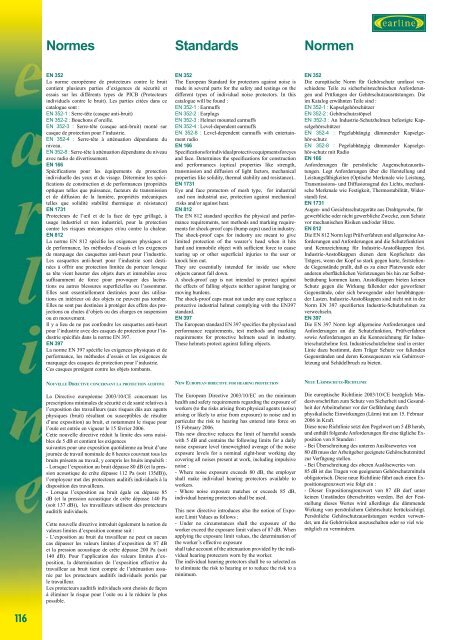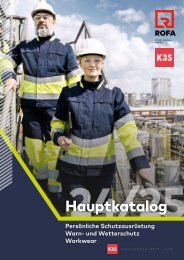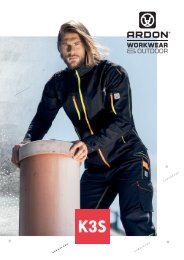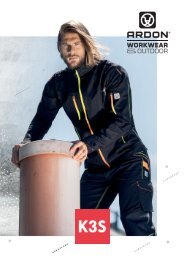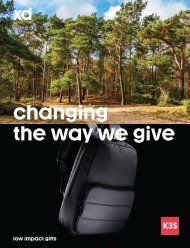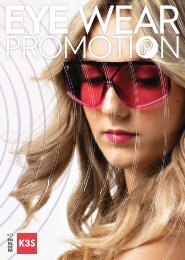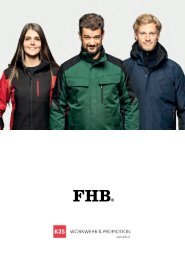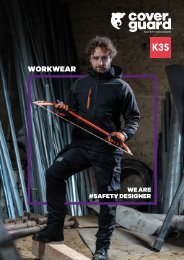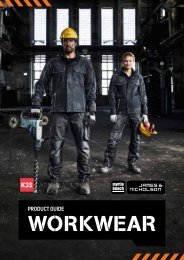K3S Earline.pdf
Gehörschutz und Schutzhelme
Gehörschutz und Schutzhelme
Erfolgreiche ePaper selbst erstellen
Machen Sie aus Ihren PDF Publikationen ein blätterbares Flipbook mit unserer einzigartigen Google optimierten e-Paper Software.
Normes Standards Normen<br />
EN 352<br />
La norme européenne de protecteurs contre le bruit<br />
contient plusieurs parties d’exigences de sécurité et<br />
essais sur les différents types de PICB (Protecteurs<br />
individuels contre le bruit). Les parties citées dans ce<br />
catalogue sont :<br />
EN 352-1 : Serre-tête (casque anti-bruit)<br />
EN 352-2 : Bouchons d’oreille.<br />
EN 352-3 : Serre-tête (casque anti-bruit) monté sur<br />
casque de protection pour l’industrie.<br />
EN 352-4 : Serre-tête à atténuation dépendante du<br />
niveau.<br />
EN 352-8 : Serre-tête à atténuation dépendante du niveau<br />
avec radio de divertissement.<br />
EN 166<br />
Spécifications pour les équipements de protection<br />
individuelle des yeux et du visage. Détermine les spécifications<br />
de construction et de performances (propriétés<br />
optiques telles que puissance, facteurs de transmission<br />
et de diffusion de la lumière, propriétés mécaniques<br />
telles que solidité stabilité thermique et résistance)<br />
EN 1731<br />
Protecteurs de l’œil et de la face de type grillagé, à<br />
usage industriel et non industriel, pour la protection<br />
contre les risques mécaniques et/ou contre la chaleur.<br />
EN 812<br />
La norme EN 812 spécifie les exigences physiques et<br />
de performance, les méthodes d’essais et les exigences<br />
de marquage des casquettes anti-heurt pour l’industrie.<br />
Les casquettes anti-heurt pour l’industrie sont destinées<br />
à offrir une protection limitée du porteur lorsque<br />
sa tête vient heurter des objets durs et immobiles avec<br />
suffisamment de force pour provoquer des lacérations<br />
ou autres blessures superficielles ou l’assommer.<br />
Elles sont essentiellement destinées pour des utilisations<br />
en intérieur où des objets ne peuvent pas tomber.<br />
Elles ne sont pas destinées à protéger des effets des projections<br />
ou chutes d’objets ou des charges en suspension<br />
ou en mouvement.<br />
Il y a lieu de ne pas confondre les casquettes anti-heurt<br />
pour l’industrie avec des casques de protection pour l’industrie<br />
spécifiés dans la norme EN 397.<br />
EN 397<br />
La norme EN 397 spécifie les exigences physiques et de<br />
performance, les méthodes d’essais et les exigences de<br />
marquage des casques de protection pour l’industrie.<br />
Ces casques protègent contre les objets tombants.<br />
EN 352<br />
The European Standard for protectors against noise is<br />
made in several parts for the safety and testings on the<br />
different types of individual noise protectors. In this<br />
catalogue will be found :<br />
EN 352-1 : Earmuffs<br />
EN 352-2 : Earplugs<br />
EN 352-3 : Helmet mounted earmuffs<br />
EN 352-4 : Level-dependent earmuffs<br />
EN 352-8 : Level-dependent earmuffs with entertainment<br />
radio<br />
EN 166<br />
Specifications for individual protective equipments for eyes<br />
and face. Determines the specifications for construction<br />
and performances (optical properties like strength,<br />
transmission and diffusion of light factors, mechanical<br />
properties like solidity, thermal stability and resistance)..<br />
EN 1731<br />
Eye and face protectors of mesh type, for industrial<br />
and non industrial use, protection against mechanical<br />
risks and/or against heat.<br />
EN 812<br />
The EN 812 standard specifies the physical and performance<br />
requirements, test methods and marking requirements<br />
for shock-proof caps (bump caps) used in industry.<br />
The shock-proof caps for industry are meant to give<br />
limited protection of the wearer’s head when it hits<br />
hard and immobile object with sufficient force to cause<br />
tearing up or other superficial injuries to the user or<br />
knock him out.<br />
They are essentially intended for inside use where<br />
objects cannot fall down.<br />
A shock-proof cap is not intended to protect against<br />
the effects of falling objects neither against hanging or<br />
moving burdens.<br />
The shock-proof caps must not under any case replace a<br />
protective industrial helmet complying with the EN397<br />
standard.<br />
EN 397<br />
The European standard EN 397 specifies the physical and<br />
performance requirements, test methods and marking<br />
requirements for protective helmets used in industry.<br />
These helmets protect against falling objects.<br />
EN 352<br />
Die europäische Norm für Gehörschutz umfasst verschiedene<br />
Teile zu sicherheitstechnischen Anforderungen<br />
und Prüfungen der Gehörschutzausrüstungen. Die<br />
im Katalog erwähnten Teile sind :<br />
EN 352-1 : Kapselgehörschützer<br />
EN 352-2 : Gehörschutzstöpsel<br />
EN 352-3 : An Industrie-Schutzhelmen befestigte Kapselgehörschützer<br />
EN 352-4 : Pegelabhängig dämmender Kapselgehör-schutz<br />
EN 352-8 : Pegelabhängig dämmender Kapselgehör-schutz<br />
mit Radio<br />
EN 166<br />
Anforderungen für persönliche Augenschutzausrüstungen.<br />
Legt Anforderungen über die Herstellung und<br />
Leistungsfähigkeiten (Optische Merkmale wie Leistung,<br />
Transmissions- und Diffusionsgrad des Lichts, mechanische<br />
Merkmale wie Festigkeit, Thermostabilität, Widerstand)<br />
fest.<br />
EN 1731<br />
Augen- und Gesichtsschutzgeräte aus Drahtgewebe, für<br />
gewerbliche oder nicht gewerbliche Zwecke, zum Schutz<br />
vor mechanischen Risiken und/oder Hitze.<br />
EN 812<br />
Die EN 812 Norm legt Prüfverfahren und allgemeine Anforderungen<br />
und Anforderungen and die Schutzfunktion<br />
und Kennzeichnung für Industrie-Anstoßkappen fest.<br />
Industrie-Anstoßkappen dienen dem Kopfschutz des<br />
Trägers, wenn der Kopf so stark gegen harte, feststehende<br />
Gegenstände prallt, daß es zu einer Platzwunde oder<br />
anderen oberflächlichen Verletzungen bis hin zur Selbstbetäubung<br />
kommen kann. Anstoßkappen bieten keinen<br />
Schutz gegen die Wirkung fallender oder geworfener<br />
Gegenstände, oder sich bewegender oder herabhängender<br />
Lasten. Industrie-Anstoßkappen sind nicht mit in der<br />
Norm EN 397 spezifierten Industrie-Schutzhelmen zu<br />
verwechseln.<br />
EN 397<br />
Die EN 397 Norm legt allgemeine Anforderungen und<br />
Anforderungen an die Schutzfunktion, Prüfverfahren<br />
sowie Anforderungen an die Kennzeichnung für Industrieschutzhelme<br />
fest. Industrieschutzhelme sind in erster<br />
Linie dazu bestimmt, dem Träger Schutz vor fallenden<br />
Gegenständen und deren Konsequenzen wie Gehirnverletzung<br />
und Schädelbruch zu bieten.<br />
116<br />
Nouvelle Directive concernant la protection auditive<br />
La Directive européenne 2003/10/CE concernant les<br />
prescriptions minimales de sécurité et de santé relatives à<br />
l’exposition des travailleurs (aux risques dûs aux agents<br />
physiques (bruit) résultant ou susceptibles de résulter<br />
d’une exposition) au bruit, et notamment le risque pour<br />
l’ouïe est entrée en vigueur le 15 février 2006.<br />
Cette nouvelle directive réduit la limite des sons nuisibles<br />
de 5 dB et contient les exigences<br />
suivantes pour une exposition quotidienne au bruit d’une<br />
journée de travail nominale de 8 heures couvrant tous les<br />
bruits présents au travail, y compris les bruits impulsifs :<br />
- Lorsque l’exposition au bruit dépasse 80 dB (et la pression<br />
acoustique de crête dépasse 112 Pa (soit 135dB)),<br />
l’employeur met des protecteurs auditifs individuels à la<br />
disposition des travailleurs.<br />
- Lorsque l’exposition au bruit égale ou dépasse 85<br />
dB (et la pression acoustique de crête dépasse 140 Pa<br />
(soit 137 dB)), les travailleurs utilisent des protecteurs<br />
auditifs individuels.<br />
Cette nouvelle directive introduit également la notion de<br />
valeurs limites d’exposition comme suit :<br />
- L’exposition au bruit du travailleur ne peut en aucun<br />
cas dépasser les valeurs limites d’exposition de 87 dB<br />
et la pression acoustique de crête dépasse 200 Pa (soit<br />
140 dB). Pour l’application des valeurs limites d’exposition,<br />
la détermination de l’exposition effective du<br />
travailleur au bruit tient compte de l’atténuation assurée<br />
par les protecteurs auditifs individuels portés par<br />
le travailleur.<br />
Les protecteurs auditifs individuels sont choisis de façon<br />
à éliminer le risque pour l’ouïe ou à le réduire le plus<br />
possible.<br />
New European directive for hearing protection<br />
The European Directive 2003/10/EC on the minimum<br />
health and safety requirements regarding the exposure of<br />
workers (to the risks arising from physical agents (noise)<br />
arising or likely to arise from exposure) to noise and in<br />
particular the risk to hearing has entered into force on<br />
15 February 2006.<br />
This new directive reduces the limit of harmful sounds<br />
with 5 dB and contains the following limits for a daily<br />
noise exposure level timeweighted average of the noise<br />
exposure levels for a nominal eight-hour working day<br />
covering all noises present at work, including impulsive<br />
noise :<br />
- Where noise exposure exceeds 80 dB, the employer<br />
shall make individual hearing protectors available to<br />
workers.<br />
- Where noise exposure matches or exceeds 85 dB,<br />
individual hearing protectors shall be used.<br />
This new directive introduces also the notion of Exposure<br />
Limit Values as follows :<br />
- Under no circumstances shall the exposure of the<br />
worker exceed the exposure limit values of 87 dB. When<br />
applying the exposure limit values, the determination of<br />
the worker’s effective exposure<br />
shall take account of the attenuation provided by the individual<br />
hearing protectors worn by the worker.<br />
The individual hearing protectors shall be so selected as<br />
to eliminate the risk to hearing or to reduce the risk to a<br />
minimum.<br />
Neue Lärmschutz-Richtlinie<br />
Die europäische Richtlinie 2003/10/CE bezüglich Mindestvorschriften<br />
zum Schutz von Sicherheit und Gesundheit<br />
der Arbeitnehmer vor der Gefährdung durch<br />
physikalische Einwirkungen (Lärm) trat am 15. Februar<br />
2006 in Kraft.<br />
Diese neue Richtlinie setzt den Pegelwert um 5 dB herab,<br />
und enthält folgende Anforderungen für eine tägliche Exposition<br />
von 8 Stunden :<br />
- Bei Überschreitung des unteren Auslösewertes von<br />
80 dB muss der Arbeitgeber geeignete Gehörschutzmittel<br />
zur Verfügung stellen.<br />
- Bei Überschreitung des oberen Auslösewertes von<br />
85 dB ist das Tragen von geeigneten Gehörschutzmitteln<br />
obligatorisch. Diese neue Richtlinie führt auch einen Expositionsgrenzwert<br />
wie folgt ein :<br />
- Dieser Expositionsgrenzwert von 87 dB darf unter<br />
keinen Umständen überschritten werden. Bei der Feststellung<br />
dieses Wertes wird allerdings die dämmende<br />
Wirkung von persönlichem Gehörschutz berücksichtigt.<br />
Persönliche Gehörschutzausrüstungen werden verwendet,<br />
um die Gehörrisiken auszuschalten oder so viel wie<br />
möglich zu vermindern.


